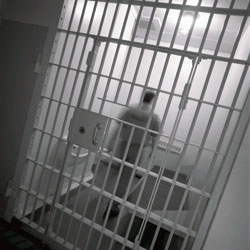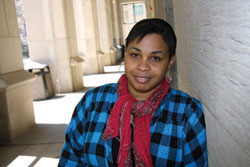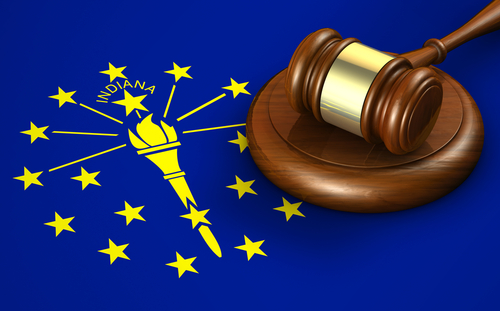Prisoner exonerations are at an all-time high, and it's not because of DNA testing

FK Photo/Corbis
Early on the morning of Sept. 11, 2006, Joseph Awe was awakened at his home in central Wisconsin by a phone call from a man who told Awe his pub was on fire.
Awe, who lived more than 30 miles away, rushed over to find his business—J.J.’s Pub in Harrisville—gutted by flames. Before firefighters and police officially determined the cause, they decided that Awe, then 36, was the primary suspect. He was charged in April 2007 after investigators concluded arson was the cause of the fire.
A disabled Gulf War veteran, Awe figured this was all a big mistake and would soon be straightened out. After all, he had nothing to hide.
But, according to prosecutors, a $200,000 insurance policy and the fact that the business was losing money were pretty strong motives for charging Awe with arson. Even after Awe was arrested, he was confident the truth would eventually come out in court.
And even when he was convicted and sentenced to three years in prison, Awe continued to hold out hope that someone would get to the bottom of this mess.
“I suffered from the delusion that innocent people get to go home,” says Awe, who served nearly all three years before being exonerated. “I thought at some point someone would do an investigation. I never gave up hope even after being convicted.”
Awe’s case was among the 87 exonerations documented in 2013, the highest yearly number ever, according to a February report (PDF) from the National Registry of Exonerations. The registry, the first of its kind in the nation, is a joint project of the University of Michigan Law School and the Center on Wrongful Convictions at Northwestern University School of Law. As of early August, the 2-year-old registry had documented 1,408 cases dating back to 1989.
Since the registry’s start, the majority of cases on the list have involved murder and rape. But that’s been shifting. The proportion of exonerations in 2013 that did not involve rape or murder was 33 percent, up from 18 percent in 1989.
Awe’s case represents a significant trend that accounts for some of that shift—convictions for which no crimes actually occurred. It turned out that the fire at his pub was electrical, not intentionally set as the original investigators concluded. Of the 87 known exonerations in 2013, 27 were cases in which no crimes had taken place. Almost half of the no-crime exonerations were for nonviolent-crime charges, mostly drug convictions.
Michigan law professor Samuel Gross, editor and co-founder of the registry, says the exonerations listed in the registry represent just a fraction of the real number because most go unreported and do not garner media attention. Gross and his colleagues rely heavily on news articles to find out about exonerations, but have often been limited to finding only high-profile cases such as murder and rape. “What we don’t know,” he says, “far exceeds what we do know.”
The use of DNA to both clear and implicate suspects prompted much of the early media attention on wrongful convictions. But exonerations due to DNA evidence have been on the decline for much of the past decade. According to the registry, the number of exonerations in which DNA played any role dropped from 23 in 2005 to 20 in 2012 and 18 in 2013.
One of the reasons for the decline is that many of the cases in which DNA testing was available to clear the wrongfully convicted have played out. DNA testing is now routine, and it often clears suspects long before trial.
Many of the defendants convicted when DNA testing was either not routine or nonexistent are losing hope for exoneration through DNA evidence because the evidence collected in their cases may no longer be available for testing.
“You have a certain number of cases in which DNA testing was never done or was not available, and a lot of those have been worked through—they’ve been sized up by an innocence project or someone who has requested DNA testing,” says Nick Vilbas, executive director of the Innocence Project of Texas.
The downward trend in DNA cases holds true for Texas and many other states that have innocence projects. “Once word got around that DNA was exonerating people, a lot of people started asking for DNA testing and a lot of those cases have been worked through,” Vilbas says. “That doesn’t mean it’s the end of DNA exonerations. We still have several DNA cases in the process right now. But they are not the bulk of our work anymore right now.”
It’s the same thing in California. “Most of our cases are non-DNA,” says Justin Brooks, a professor at California Western School of Law and project director of the California Innocence Project. “There have not been many in California in the past 15 years.”
Brooks describes the early DNA cases as “low-hanging fruit,” many involving cases in which rape kits could provide evidence to help exonerate those convicted when DNA testing became more prevalent.
The bulk of the work for innocence projects like the one in California is on cases involving false confessions, discredited scientific evidence and unreliable witnesses, along with other factors, including prosecutorial misconduct. One of the benefits of the registry is that it offers insights into how people were wrongfully convicted and where the system failed, which can be useful in bringing about legislative and judicial reforms.
“It shines the light on the entire criminal justice system,” Brooks says. “If we’re making mistakes in the biggest kinds of cases, such as death penalty cases, what does that say about lower-level crimes?”
Awe’s case, for example, brought to light the use of questionable expert witnesses who reached scientific conclusions later found to be unreliable. In addition, it turned out that the arson experts who testified for the prosecution were hired by the insurance company, which had a stake in the outcome. The experts claimed there was no other possible cause for the fire, so it must have been intentionally set. Awe testified in his own defense and explained that the 130-year-old building had extensive electrical problems.

Photo of Joseph Awe by Bob Stefko
After he was convicted, Awe came to realize he was going to prison. “I was as prepared as I could be,” he says. “You have to keep to yourself. I kept my mouth shut and didn’t say nothing to no one.”
In 2011, the Wisconsin State Journal published articles questioning the neutrality of the hired experts and presented opinions of independent fire experts who concluded that electrical problems caused the fire. Awe filed a motion for a new trial, which was granted in March 2013, and prosecutors dismissed the charge in April.
The judge who overturned the conviction cited the misuse of “negative corpus”—the idea that because investigators could not determine whether the fire was accidental or natural, it must have been intentional. After Awe’s conviction, the National Fire Protection Association updated its guide to say negative corpus should not be used to conclude a fire was intentionally set.
Stephen J. Meyer of Madison, Wisconsin, who represented Awe during his appeal, says the case raised red flags all around. “I knew about this case and I knew he had been screwed,” Meyer says. “Joe was as patient as could be. I knew I was looking at a guy who was innocent.”
Meyer consulted his own experts, including a former fire marshal. He learned that the insurance investigators were allowed to walk through the property at the same time as local fire investigators. “They’re never supposed to let insurance investigators in there until they’re done,” Meyer says.
Rob Warden, executive director of the Center on Wrongful Convictions at Northwestern University School of Law, says by documenting such cases, the registry can help support reforms to prevent similar problems in the future. “We need to quantify the data to support the reform movement,” he says.
For example, in an attempt to curb psychologically coerced confessions, the center advocated for laws requiring police to record interrogations as well as confessions. By shedding light on what happens before a person confesses, the veracity of such confessions can be scrutinized.
In 2003, Illinois began requiring police to record more homicide interrogations, and last year it expanded the law to include other felonies to help prevent false confessions and wrongful convictions.
While confessions by torture receive widespread publicity, mostly because of the cases involving former Chicago Police Lt. Jon Burge, they are the exception. “Most people are shocked at the number of confessions that are psychologically coerced,” Warden says.
Other reform measures address police lineup procedures to prevent wrongful identifications by recording those sessions as well. “One phenomenon we’ve seen is that a victim or a witness might make a tentative ID of someone and police record that they made a positive ID. We’ve seen a lot of instances where the police officer comes to court and says this person made an ID and it was very positive.”
Like his colleagues, Warden doesn’t believe police intend to frame people or convict the innocent. When they believe someone is guilty, they simply “tweak” the evidence in their favor, thinking they are doing good.

Photo of Nicole Harris courtesy of Center on Wrongful Convictions
Police may have thought they were doing good when they arrested Nicole Harris of Chicago on charges she killed her 4-year-old son, Jaquari, in 2005.
Harris’ boyfriend found Jaquari in a bedroom asphyxiated by an elastic band from a fitted bedsheet wrapped around his neck. Police were suspicious and questioned Harris over a period of 27 hours. She later said that the officers threatened her, pushed her, called her names, and denied her food, water and use of the bathroom.
Worn out and afraid, Harris gave a videotaped confession saying she strangled the boy with the elastic band because he would not stop crying after she disciplined him for leaving the apartment. She was charged with first-degree murder and tried in October 2005.
Police questioned Jaquari’s 6-year-old brother, Diante, about what happened. The boy said that his brother liked to pretend he was Spiderman by wrapping the sheet’s elastic band around his neck and jumping off the bed. The jury never heard this story because the judge found that Diante was incompetent to testify. The jury convicted Harris and she was sentenced to 30 years in prison.
She wrote a letter to the Northwestern Center on Wrongful Convictions. Thanks to help from Northwestern lawyers and the law firm of Jenner & Block, which offered pro bono services, Harris was exonerated eight years later when it came to light that police coerced her into confessing and Diante saw his little brother wrap the band around his neck while playing.
How can the registry help someone like Harris? “That’s a question we ask ourselves all the time,” says Alison Flaum, one of her lawyers from Northwestern. “We are always thinking about systemic reform and how these cases can be prevented from happening again.”
Police had already made up their minds, Flaum says. “This was a case of investigator tunnel vision. They interrogated her with the goal of getting a confession,” she says. “They extracted a confession from a grieving mother.”
And that worked in their favor. She was vulnerable and not herself. She had collapsed in the hospital upon hearing her son had died. Another factor that worked against her was that the medical examiner’s office, which initially concluded Jaquari’s death was accidental, changed the ruling to homicide after learning of the confession. “A lot of people might not realize this, but the medical examiner is part of the investigation. They are not objective scientists in a white coat,” Flaum says. “They are part of the prosecution package.”
Once again, it was a case in which people might think: If she confessed, she must have done it. Why would anyone confess to a crime they didn’t commit? “Sometimes they confess because they think because they’re innocent that it will all get straightened out later,” Flaum says. “Innocence can work against an innocent person that way. People trust you are telling the truth if you confess.”
The truth finally came out in pub owner Awe’s case, and he was released just two months before his three-year sentence was to expire. While he felt joy in his exoneration, there are scars and aftereffects. Awe has trouble sleeping and says he has psychological problems. “It’s not easy getting out,” he says. “I’m probably not the same person I was.”
Prison left him edgy, nervous, on the defensive. “I can’t sleep next to my wife,” he says. “When you’re in prison, you’re terrified that someone will get you when you’re asleep.”
He spends his time fishing, hunting and visiting with his grandchildren. “I have three years to make up for,” he says. “I would hate for anyone to go through what I have gone through.”
Yet the numbers show that others are indeed going through it, as lawyers find more innocent people behind bars. For the first three months of 2014, exonerations were already occurring at a faster rate than the previous year, and the registry added 24 cases. “It’s a strikingly fast rate,” Gross says.
This article originally appeared in the September 2014 issue of the ABA Journal with this headline: “The Age of Innocents: Prisoner exonerations are at an all-time high. But for many, no crime was ever committed, a study shows.”
Sidebar
10 Key Problems
During the last decade, the ABA’s Criminal Justice Section has focused attention on the problem of wrongful convictions and the factors that contribute to such convictions.
The section has identified the following 10 key problems, according to Stephen Saltzburg, a member of the CJS executive committee:
1. Mistaken identifications and suggestive identification procedures.
2. Unreliable statements by jailhouse informants seeking personal advantage.
3. Questionable, even deceitful, forensic evidence techniques.
4. Levels of training of lab technicians.
5. A lack of universal and uniform accreditation standards for labs and certification of laboratory analysts and examiners. (See “Crimes in the Lab,” ABA Journal, September 2013.)
6. Misleading or overstated testimony by expert witnesses.
7. Independence of labs. (See “CSI Breakdown,” ABA Journal, November 2010.)
8. The lack of available forensic laboratory services to indigent defendants.
9. Inadequate precautions against human error, confirmation bias and contextual bias.
10. Inadequate understanding of DNA and other science.
Possible Solutions
A series of 10 recommendations to address those problems were detailed in a 2006 Criminal Justice Section report titled Achieving Justice: Freeing the Innocent, Convicting the Guilty, co-edited by Paul Giannelli and the late Myrna Raeder.
In addition, the ABA House of Delegates passed a series of resolutions intended to encourage jurisdictions to take steps to reduce the likelihood of wrongful convictions by addressing the issues. Among the major recommendations:
• Law enforcement agencies should videotape the entirety of custodial interrogations of crime suspects at police precincts, courthouses, detention centers or other places where suspects are held for questioning. Where videotaping is impractical, the policy calls for audiotaping the entirety of custodial interrogations.
• An eyewitness policy requiring police and prosecutors to: (1) craft guidelines for conducting lineups and photo spreads that maximize their accuracy; (2) provide their personnel with periodic training on implementing such guidelines; (3) create internal mechanisms for enforcing and updating the guidelines; and (4) train their personnel in nonsuggestive techniques for interviewing witnesses.
• Crime laboratories and medical examiner offices should be accredited, examiners should be certified, and procedures should be standardized and published to ensure the validity, reliability and timely analysis of forensic evidence.
• No prosecution should occur based solely upon uncorroborated jailhouse informant testimony.
• Jurisdictions should enact statutes to adequately compensate individuals convicted and incarcerated for crimes they did not commit.
One of the most key contributions of the section was drafting and proposing additions to Rules 3.8(g) and (h) of the ABA Model Rules of Professional Conduct. Those rules impose new ethical responsibilities on prosecutors when they possess or are provided information indicating that an individual may have been wrongfully convicted, even if the conviction occurred in another jurisdiction.
Section prosecutors supported this resolution and its obligations to give notice and to inquire further where appropriate, in recognition of their roles as ministers of justice seeking to exonerate the innocent as well as convict the guilty
Idaho is the sole state that has adopted Rules 3.8(g) and (h), while 10 others have adopted modifications of them (Arkansas, Arizona, Colorado, Delaware, Hawaii, New York, North Dakota, Tennessee, Washington and Wisconsin.) Six jurisdictions are studying the rules (California, the District of Columbia, Nebraska, New Hampshire, Pennsylvania and Vermont).
Kevin Davis is a freelance journalist based in Chicago.



